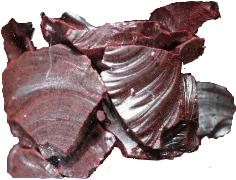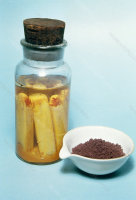  Phosphorus is element number 15 on the periodic table. At room temperature it is a semitransparent, soft, waxy solid that glows in the dark ('phosphorescence'). Its high reactivity means that it seldom occurs in this free state; instead it appears as the phosphate ion PO4.
Phosphorus is element number 15 on the periodic table. At room temperature it is a semitransparent, soft, waxy solid that glows in the dark ('phosphorescence'). Its high reactivity means that it seldom occurs in this free state; instead it appears as the phosphate ion PO4.Phosphorus is a very widely distributed element; it's the 12th most abundant element in Earth's crust. About 550 different minerals have been found to contain phosphorus. Phosphate is a phosphorus atom with four oxygen atoms. It is located in water, soil and sediments. The quantities of this phosphorus ion in soil are usually small, limiting plant growth, which is why phosphate fertilizers are often applied to farmland. Animals absorb phosphates by eating plants or plant-eating animals. Phosphorus is an essential nutrient for animals and plants. It is critical for cell development and is a key component of DNA and lipids (fats and oils), as well as molecules that store energy (ATP & ADP). Phosphate is also an important component of bones and teeth. It is fluoride's ability to convert tooth phosphate from one form to a harder, more decay-resistant form that helps lessen tooth decay. Phosphoric acid is a weak but corrosive acid that's used in many industrial and household applications.  Elemental phosphorus can exist in several allotropes, the most common of which are white and red solids. Allotropes are different structural forms of the same element, and these can exhibit quite different physical properties and chemical behaviours.
Elemental phosphorus can exist in several allotropes, the most common of which are white and red solids. Allotropes are different structural forms of the same element, and these can exhibit quite different physical properties and chemical behaviours.
|